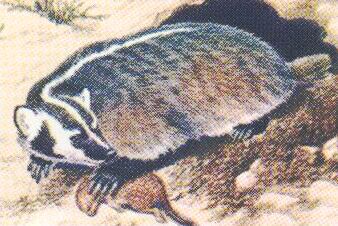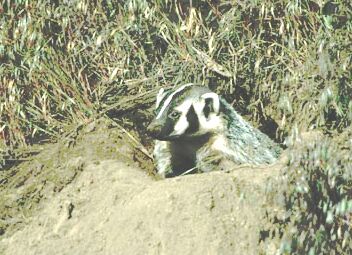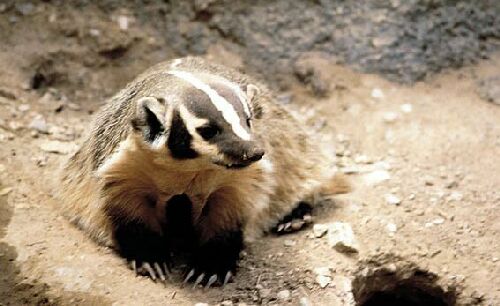
Where the badger lives
This mammal is found in some areas of Quebec and Ontario,
in the prairie provinces and in British Columbia.
The badger likes the wide open country (prairies and grasslands) where it
is easier to catch its prey.
It uses its sharp claws to dig underground burrows.
The badger's home is lined with leaves and grass.

a badger looking out of its burrow
Appearance
A badger's face is black and white, with a white stripe
from its nose to its shoulders.
It has short legs and a flat body.
The long silvery-grey hairs drag along the ground so you can
hardly see its legs. The badger has very long claws on its front legs.
This mammal is about 23 cm. high and 60 cm. long from head to tail.
Food
A badger usually comes out in the evening to look for ground squirrels,
gophers, mice, rats, birds' eggs, lizards and snakes. The badger is not very fast but it trails animals
to their dens. Then it starts to dig. In a few seconds it can dig down to where
the animal is hiding.
Adaptations
The badger sleeps in its burrow during the winter and lives off
body fat. It does not hibernate.
The claws on its front feet are long. When it is trying to escape, it digs with
all four feet. Dirt flies into the air and quick as a wink the badger is
out of sight.
Not many animals will dare to attack the badger because of its long claws and sharp teeth.
The badger is a fierce fighter.
The badger's long thick hair protects it from snake bites and from enemies.

Enemies
The coyote and man are its worst enemies.
Man hunts and traps badgers. Badgers are hit and killed by cars.
Babies
In April, May or June two to five babies are born.
In five or six weeks their eyes are open.
The mother brings them food to eat.
Later she teaches them how to hunt.
In the fall the young ones leave and go off to dig their own burrows.
Go to CANADIAN ANIMALS
Badger report
photo credits:
photo 1 - U.S. Fish and Wildlife Service; Photographer: Tupper Ansel Blake
photo 2 - U.S. Fish and Wildlife Service
http://www.fhwa.dot.gov/environment/wildlifecrossings/photo09.htm
|

